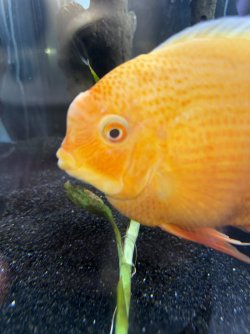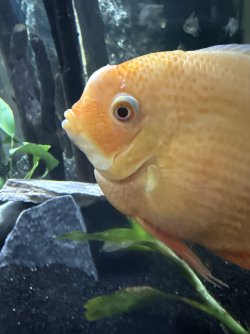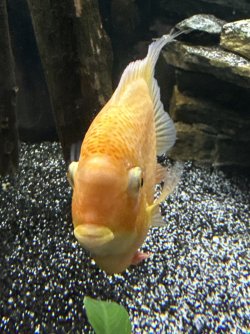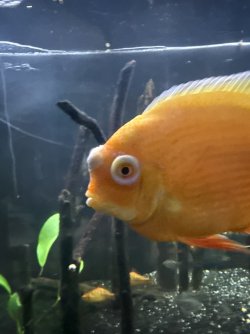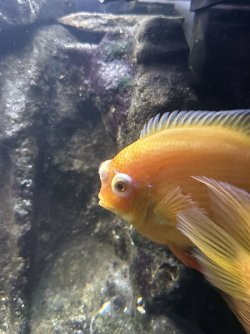Is the other eye swollen up and white too?
It's excess mucous over the eye but the eye also looks like it's bulging out more than normal. You will be able to see both sides of the fish to see if it is sticking out more. That is normally caused by an injury to the eye or an infection or swelling in the skull. An infection in the brain or skull can be from bacteria, virus or protozoa. It's unlikely to be protozoan because your tank should be pretty clean and protozoan infections in the brain cause the fish to lose balance and spin/ spiral in circles as it progresses.
Swelling in the brain is usually from an injury and should go down after a few days. This hasn't improved, which is a bad sign.
In one of the pictures the original area looks like it is slightly red under the skin, which is an infection. It might be the picture but if it looks red instead of the normal skin colour, then it's infected.
Time for a broad spectrum medication that treats bacteria, fungus. If you can't find anything like that then add some salt until you can get some medication.
---------------------
Make sure you work out the tank volume before treating. The link below is for the calculator on the forum.
When you measure the height, measure from the top of the substrate to the top of the water level.
If you have big rocks or driftwood in the tank, remove these before measuring the height of the water level so you get a more accurate water volume.
You can use a permanent marker to draw a line on the tank at the water level and put down how many litres are in the tank at that level.
Remove carbon from the filter before treating with chemicals or it will adsorb the medication and stop it working. You do not need to remove the carbon if you use salt.
Increase aeration/ surface turbulence when using salt or medications because they reduce the oxygen in the water.
If you can move the fish into a smaller tank it will require less medication.
---------------------
INSTRUCTIONS FOR USING SALT
You can add rock salt (often sold as aquarium salt), swimming pool salt, or any non iodised salt (sodium chloride) to the aquarium at the dose rate of 1 heaped tablespoon per 20 litres (5 gallons) of water. If there is no improvement after 48 hours you can double that dose rate so there is 2 heaped tablespoons of salt per 20 litres (5 gallons).
Keep the salt level like this for a week. If there's no improvement after a few days it probably won't help and you can stop using it.
The salt will not affect the beneficial filter bacteria, fish, plants, shrimp or snails.
After you use salt and the fish have recovered, you do a 10% water change each day for a week using only fresh water that has been dechlorinated. Then do a 20% water change each day for a week. Then you can do bigger water changes after that. This dilutes the salt out of the tank slowly so it doesn't harm the fish.
If you do water changes while using salt, you need to treat the new water with salt before adding it to the tank. This will keep the salt level stable in the tank and minimise stress on the fish.
When you first add salt, add the salt to a small bucket of tank water and dissolve the salt. Then slowly pour the salt water into the tank near the filter outlet. Add the salt over a couple of minutes.

